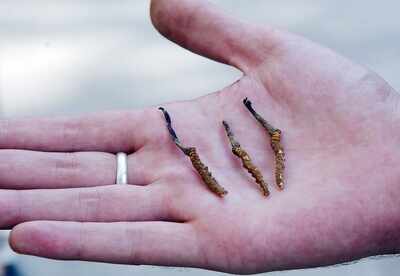
DEHRADUN: The world’s costliest fungus — Ophiocordyceps sinensis — also known as Himalayan Viagra, which sells in international markets for upwards of Rs 20 lakh per kg, has entered the International Union for Conservation of Nature’s (IUCN) Red List of Threatened Species, the world’s most comprehensive information source on the global conservation status of animal, fungi and plant species. The list which was released on July 9, has placed the fungus, known for its aphrodisiac and rejuvenation properties, in the ‘vulnerable’ category.
Citing the reason for placing the fungus in the vulnerable category, IUCN said “its spread has declined by at least 30% over the past 15 years as a result of overharvesting.” The fungus, also known as keeda jadi in Uttarakhand because of its caterpillar-like appearance, is endemic to the Himalayan and Tibetan plateau and is found in China, Bhutan, Nepal and India. In India, it is primarily found in Uttarakhand in the higher reaches of districts like Pithoragarh and Chamoli.
Speaking to TOI, Vivek Saxena, India representative of IUCN, said, “The purpose of putting the fungus in the Red List under the ‘vulnerable category’ is to ensure that proper government policies are implemented in order to conserve it so that it remains in the wild.”
Meanwhile, the inclusion in the Red List is going to impact hundreds of villagers of Uttarakhand who were dependent on collecting the fungus as their primary source of livelihood. The fungus sells locally for around Rs 10 lakh per kg and goes on to be sold in international markets like China (where it is highly prized) at upwards of Rs 20 lakh per kg.
Citing the reason for placing the fungus in the vulnerable category, IUCN said “its spread has declined by at least 30% over the past 15 years as a result of overharvesting.” The fungus, also known as keeda jadi in Uttarakhand because of its caterpillar-like appearance, is endemic to the Himalayan and Tibetan plateau and is found in China, Bhutan, Nepal and India. In India, it is primarily found in Uttarakhand in the higher reaches of districts like Pithoragarh and Chamoli.
Speaking to TOI, Vivek Saxena, India representative of IUCN, said, “The purpose of putting the fungus in the Red List under the ‘vulnerable category’ is to ensure that proper government policies are implemented in order to conserve it so that it remains in the wild.”
Meanwhile, the inclusion in the Red List is going to impact hundreds of villagers of Uttarakhand who were dependent on collecting the fungus as their primary source of livelihood. The fungus sells locally for around Rs 10 lakh per kg and goes on to be sold in international markets like China (where it is highly prized) at upwards of Rs 20 lakh per kg.
Download
The Times of India News App for Latest India News

Coronavirus outbreak
Trending Topics
LATEST VIDEOS
India
 Covid-19: More cities to come under lockdown
Covid-19: More cities to come under lockdown  Spike in COVID-19 cases witnessed in Srinagar after lifting lockdown: DM
Spike in COVID-19 cases witnessed in Srinagar after lifting lockdown: DM  ITBP DG hails MHA’s proposal to incorporate ‘transgender’ as Third gender in CAPF Exams
ITBP DG hails MHA’s proposal to incorporate ‘transgender’ as Third gender in CAPF Exams  16-feet-long Burmese python rescued in Assam’s Nagaon
16-feet-long Burmese python rescued in Assam’s Nagaon  Ram Madhav, Jitendra Singh meet family of Wasim Bari in Bandipora
Ram Madhav, Jitendra Singh meet family of Wasim Bari in Bandipora  Monsoon session will be held with precautions: Parliamentary Affairs Minister
Monsoon session will be held with precautions: Parliamentary Affairs Minister
More from TOI
Navbharat Times
Featured Today in Travel
Quick Links
Coronavirus in MumbaiCoronavirus in KolkataCoronavirus in HyderabadCoronavirus in DelhiCoronavirus in BangaloreCoronavirus symptomsCoronavirus in IndiaWhat is CoronavirusCoronavirus NewsSolar EclipseNPRWhat is NRCCAB BillCAB and NRCRTI BillPodcast newsLok SabhaShiv SenaYSRCPCongressBJP newsUIDAIIndian ArmyISRO newsSupreme Court
Get the app



